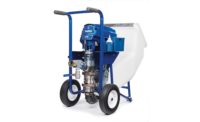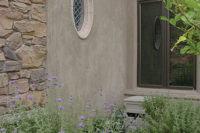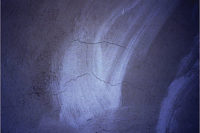Back in my mud-slinging days, we did a whole lot of pumping. We pumped stucco on big jobs and small jobs, and when we hit the jobsite, we were like ants on an apple. Every worker had their individual tasks but we all worked together, as one unit, in harmony. First the nozzleman, hose puller and hoddy, would set about getting the pump prepped and the hose lined out. Everyone else was masking the area where we would be starting and would continue masking in the direction of the areas we wanted to complete that day.
This was about a half hour worth of team effort before the mud would hit the end of the hose and then, it was game time. We first brought up the rod or darby guys, usually two of them, and kept the rest still masking. Spray, spray, spray, knockdown, knockdown, knockdown and when it was time to float, we brought up a float guy or two while the rest kept on masking. Same dance, every job, regardless of the size. Oh... what a thing of beauty, we belonged to a team of professionals working as one, hitting goals, kicking butt and taking names, Stuccotopia.
I still remember my first EIFS job like it was yesterday. We worked as a crew but we all worked independently, on different parts of a given elevation. I distinctly remember being left to work alone, pulling backwrap at the base, windows and doors. This was different, working all alone, no buds to regale tall tales with, no silly songs to sing, no “waawaawaa” of the pump.
It was about five years later when I was working with my brothers that we began to pump EIFS. My younger brother, who was my boss, told me one day that we were going to pump a big EIFS job using a Hy-Flex pump. It was a small machine with an open hopper, and a rotor and stator pumping mechanism, driven by an electric motor. My first reaction was no way—nobody pumps EIFS, especially with a dinky pump like this. My brother is a very determined individual (stubborn) and was absolutely convinced it would work. I asked him what he knew about a pump crew and pumping in general. “You remember, I fed the gun for a couple summers and saw how a pump crew worked,” was his reply. “Trust me it’ll work.”
I hate to admit that he was right, pumping EIFS turned out to be hugely successful and reminiscent of my stucco pumping days, yes, my own EIFStopia. Here is how we did it.
The Crew
We had a nozzleman, a hoddy, one hose puller (with some trowel skills, usually an apprentice), a mesh-roller guy (who doubled as a trowel guy), a mesh-embedder trowel guy, and a trowel finisher guy. Somehow my brother was never part of the crew. We ran the mesh horizontally and affectionately referred to the pump crew as “the train.” In pulling the backwrap, we typically didn’t use the pump because it wasn’t any faster than each man hand netting a window or door. But, we always used the pump at the bottom of the wall, and the top of the wall, to pull the backwrap.
Mixing and Loading the Pump
The masking and dropping back procedure is the same as the stucco pumping I described earlier. One big difference is that when your hoddy is mixing mud, you can’t just fill the hopper with mud and go like you can with stucco. First, have the hoddy mix about five pails of basecoat. Leave them in the “slake” state. (Slake: the time period one should allow for the water to fully absorb into the cement in the mix before final re-mixing and use, to make for longer pot-life.) Only spin-up the pail that you are going to put in the hopper and leave the rest slaked, moving up in the line as you use each one. New mixes go to the back of the five pail line. We found that you can leave the pail slaked for about an hour as long as you keep it covered with a layer of water; just enough to cover the mud surface, and in the shade (remember the Hoddy Shack?).
To prime the hose we used an acrylic finish primer for the “slip,” about 2 to 3 gallons worth. Run that through the hose and when it hits the end of the hose, save it into a 5-gallon pail to use again and again. As soon as all the primer leaves the hopper, pour in a pail of the already slaked and re-spun basecoat. Don’t worry about rinsing the residual primer from the sides, the mud will do that, plus you don’t want to chase water after the primer before the mud. The mud should be slightly looser than you would have for hand jiving (adjust as necessary but do not make it soupy).
Keep putting just enough mud in the hopper to get it all the way to the end of the hose. Then, fill the hopper to about three-quarters full and lay a layer of water on top to completely cover the mud, about 1-inch worth. This will keep the mud fresh and when you add another pail, the mud will sink and the water will rise to the top again. (Throughout the day, always keep a layer of water on top.) A hopper refill should be a whole pail worth, try not to dump pail portions as this will affect hopper pot-life. Keep the sides of the hopper, above the mud level clean, so as not to send clinkers to the nozzle. Our hoddy used a moist sponge float to wipe down the sides, leaving the extra water from the float added to the top water layer.
The Train
We used about 250 feet of 1½ ID hose, the same type hose that is used in pumping stucco. The nozzle was a smaller version of the same ones used in stucco pumping, with the addition of a mud shut-off valve near the swivel and a ball cock valve before the air stem, to regulate the airflow. I never used a shield and typically had a 1/4 or 3/8 orifice and cap. All of the backwrapping on the elevation you are working on should be done. Begin at the top of the wall and gauge the width of the mesh for the first run. Most EIFS manufacturers have rolls of mesh in 3- or 4-foot widths. You are going to get approximately two widths per scaffold level. Spray enough mud to completely cover the foam, in the width of the mesh only, adjusting the air pressure to make a complete coverage pattern without having to put it too thick. Then the train will follow, the roller guy lays out the mesh, the first trowel guy sort of pins in the mesh without wrinkles, and the following trowel guys fully embed the mesh and finish it off.
Do not let your guys fling excess mud to the ground, instead place extra into a clean bucket. (They’ll use it on the finish pass.) Have the last trowel guy rake the mud back off the bottom 2 inches of mesh to minimize the hump of the overlap from the next layer of mesh. Now go back in the other direction, just below your first pass, and lay down the second pass of mesh. Again have the last trowel guy rake back the mud on the bottom 2 inches. Then, for the final base coat pass, you will again go back in the other direction covering all of the mesh area. This is the sweetener coat, the second pass recommended by all EIFS manufacturers.
Spray a very light coat over all of the freshly embedded mesh not really covering 100 percent of the area but enough so the trowel guys can lay out a full coverage pass of basecoat, enough to fully cover the mesh pattern. (For this finish pass, I used to turn down the airflow to spit out a more globular pattern. The mud would stay wetter than when I used a high air pattern.) So the “train” went; left-to-right, right-to-left, left-to-right, drop down a level and repeat. Before you drop down a level make sure someone scrapes any overspray off un-meshed foam—this is a critical step.
The Finish
If you are dashing the whole building then it is pretty straight forward. Pick a finish, appropriate orifice size, adjust the air pattern and go. Do not use a nozzle shield, just the orifice and cap will do. You are also going to need a poker device, heavy gauge wire will do, for the end of the air stem. The air stem tends to clog when spraying acrylics. For floated finishes I would not recommend using the pump. We tried it, spraying the finish, troweling it down and floating it but it was just too intense with timing, overspray, jointing, multiple levels etc. We did however use the pump to spray the pop-outs. Just use a smaller orifice and a little more air and you can successfully replicate a floated sand finish. With a rotor and stator you can pump base coat for a long time, weeks. But with the acrylic finishes you will only get about 150 to 200 pails of finish pumped before you have to change the stator and tube. The finish aggregate just wears them out fast.
If you have a good crew who knows how to pump stucco, you can successfully pump EIFS. Note: Do not try to use your piston and manifold pump for EIFS; instead use a rotor and stator or peristaltic type pump, of which there are many variations in the market. These pumps deliver a steady flow of pressure to push the smoother consistencies of EIFS products. EIFS pumping crews can be fun and are definitely very productive. Spray it forward.







Report Abusive Comment